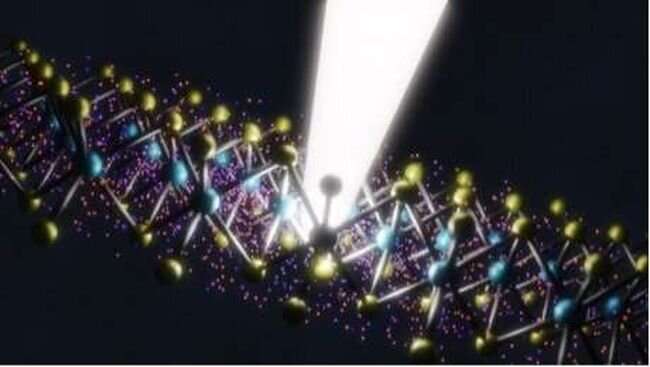January 20, 2023 feature
This article has been reviewed according to Science X's editorial process and policies. Editors have highlighted the following attributes while ensuring the content's credibility:
fact-checked
peer-reviewed publication
trusted source
proofread
The Floquet engineering of quantum materials

Quantum materials are materials with unique electronic, magnetic or optical properties, which are underpinned by the behavior of electrons at a quantum mechanical level. Studies have showed that interactions between these materials and strong laser fields can elicit exotic electronic states.
In recent years, many physicists have been trying to elicit and better understand these exotic states, using different material platforms. A class of materials that was found to be particularly promising for studying some of these states are monolayer transition metal dichalcogenides.
Monolayer transition metal dichalcogenides are 2D materials that consist in single layers of atoms from a transition metal (e.g., tungsten or molybdenum) and a chalcogen (e.g., sulfur or selenium), which are arranged into a crystal lattice. These materials have been found to offer exciting opportunities for Floquet engineering (a technique to manipulate the properties of materials using lasers) of excitons (quasiparticle electron-hole correlated states).
Researchers at the SLAC National Accelerator Laboratory, Stanford University and University of Rochester have recently demonstrated the Floquet engineering of excitons driven by strong fields in a monolayer transition metal dichalcogenide. Their findings, presented in a paper in Nature Physics, could open new possibilities for the study of excitonic phenomena.
"Our group has been studying strong-field driven processes such as high-harmonic generation (HHG) in 2D-crystals subjected to intense mid-infrared laser fields," Shambhu Ghimire, one of the researchers who carried out the study, told Phys.org.
"We are very interested to understand the detailed mechanism of the HHG process, and 2D-crystals seem to be a fascinating platform for this, as they are something in between isolated atoms in the gas phase and the bulk crystals. In the gas phase, the process is understood by considering the dynamics of the laser field ionized electron and its recombination to the parent ion."
When exposed to strong laser fields, 2D crystals can host strongly-driven excitons. In their previous research, Ghimire and his colleagues explored whether driving these quasiparticles with strong laser fields and measuring high harmonics would allow them to better understand the solid-state HHG process.
"While this previous work was the inspiration for our study, we also started measuring the change in absorption on these driven systems and learned more about the non-equilibrium state of the material itself," Ghimire explained. "Indeed, we find that there are previously not observed absorption features that can be linked to what's known in the literature as the Floquet states of the materials subjected to strong periodic drives."
In their experiments, the researchers used high-power ultrafast laser pulses in the mid-infrared wavelength range to monolayer tungsten disulfide (TMDs). The use of these ultrafast pulses allowed them to avoid the sample damage that typically results from strong light-matter interactions.
More specifically, the photon energy of mid-infrared laser pulses is around 0.31 eV, which is significantly below the optical bandgap of monolayer TMDs (~2 eV). Therefore, the team did not expect to observe a particularly sizable generation of charge carriers.
"At the same time, the photon energy in our set up is tunable and can be resonant to exciton energies of the monolayer," Ghimire said. "To fabricate our material samples, we collaborated with the team of Prof. Fang Liu at Stanford Chemistry. This group has pioneered a new approach to fabricate millimeter scale monolayer samples, which was also a key to the success of these experiments."
Yuki Kobayashi, a postdoctoral scholar, who is the lead author of the paper said that they unveiled two new mechanisms for creating quantum virtual states in monolayer TMDs. The first of these involves Floquet states, which are attained by mixing the quantum states of materials with external photons, while the second involves the so-called Franz-Keldvsh effect.
"We found that an originally dark exciton state can be optically bright by mixing with single photon, being manifested as a separate absorption signal below the optical bandgap," Kobayahsi said. "The second mechanism we unveiled is the dynamic Franz-Keldysh effect. This is caused by the external laser field triggering momentum kick to the excitons, leading to universal blue shift of the spectral features. This effect was observed because we applied a high-field laser pulse (~0.3 V/nm) that is strong enough to break apart the electron-hole pair."
Combining the two mechanisms they unveiled, Kobayashi and his colleagues were able to achieve an energy tuning over 100 meV in their sample of monolayer TMDs. These notable results highlight the huge potential of this monolayer transition metal dichalcogenide as a platform to realize strong-field excitonic phenomena.
"One of the unanswered questions in our work is the real-time response of strong-field excitonic phenomena: how fast can we turn on and off the virtual quantum states?" Ghimire added. "We expect that, by going beyond the perturbative domain, it will be possible to imprint the oscillation patterns of laser carrier waves in the virtual quantum states, approaching the sub-petahertz regime of optical property control."
More information: Yuki Kobayashi et al, Floquet engineering of strongly driven excitons in monolayer tungsten disulfide, Nature Physics (2023). DOI: 10.1038/s41567-022-01849-9
Hanzhe Liu et al, High-harmonic generation from an atomically thin semiconductor, Nature Physics (2016). DOI: 10.1038/nphys3946
P. B. Corkum, Plasma perspective on strong field multiphoton ionization, Physical Review Letters (2002). DOI: 10.1103/PhysRevLett.71.1994
Shambhu Ghimire et al, High-harmonic generation from solids, Nature Physics (2018). DOI: 10.1038/s41567-018-0315-5
Fang Liu, Mechanical exfoliation of large area 2D materials from vdW crystals, Progress in Surface Science (2021). DOI: 10.1016/j.progsurf.2021.100626
Journal information: Physical Review Letters , Nature Physics
© 2023 Science X Network




















